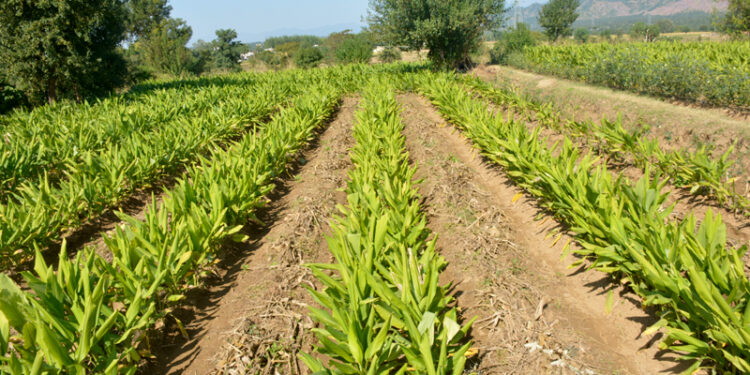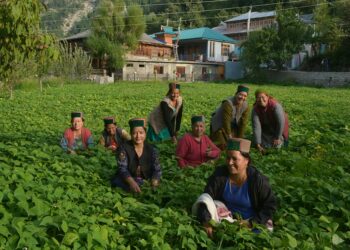
Executive Director, Prakritik Kheti Khushhal Kisan Yojna, Himachal Pradesh.
Agriculture has been contributing 45 per cent to the total income of the inhabitants in the Indian Himalayan region. Himachal Pradesh, being an important State of this region, has predominantly small and fragmented land holdings, undulating topography and rain fed cultivation conditions. However, the farmers of this mountainous state are also credited with turning their toughly accessed, fragmented, sandy, fridged and slopy land to the core of apple and off-season vegetable cultivation fields.
The agriculture contributes nearly 45 per cent to the net state domestic product. Nearly 93 per cent of the Himachal’s population depends directly upon agriculture. Fruit cultivation, especially apple, has also proved to be an economic boon, and is the mainstay of over 1.7 lakh families. The State’s economy worth of ₹ 3,500 crore from apple and ₹4,000 crore from off-season vegetables was not only its backbone but also supports thousands of others such as transporters, carton manufacturers/suppliers, CA Store/Cold Chain owners, wholesale fruit dealers, fruit processing unit owners etc. from other states. Whereas, average income of individual in Himachal Pradesh has reached to incredible level of 1.95 lakh, farmers are resorting to excessive and indiscriminate use of pesticides to increase their production. The pest management strategies being adopted by farmers are mainly dependent on the advice from vendors and the marketing strategies of pesticide companies.
STUDIES HAVE SHOWN THAT EXCESSIVE USE OF CHEMICAL FERTILIZERS AND PESTICIDES HAS IMPACTED ADVERSELY ON THE SOILS, PRODUCTIVITY, BIO DIVERSITY AND HUMAN HEALTH OF THE REGION.
Rachel Carson, an American brave environmentalist, however, raised the first alarm on adverse environmental effects caused by the indiscriminate use of pesticides through a book ‘Silent Spring’ written in September 1962. In her mind altering documentation, Carson accused the chemical industry of spreading misinformation, and public officials of accepting the industry’s marketing claims unquestioningly. One renowned agricultural strategist, Mr. Devender Sharma has mentioned that the father of Green Revolution, Nobel laureate Norman E. Borlaug in the mid-1980s had labelled her as an evil force. Mr. Borlaug described that ‘these are the kind of people who don’t want hunger to go away’ and explained that pesticides are like medicines.

As per a published report, around 10,000 pesticide poisoning cases are reported every year in India. We are reported to eat food, carrying some of the highest toxic pesticide residues found in the world. There has been a 2 fold increase in samples containing pesticides above the Maximum Residue Limit (MRLs) in vegetables, fruits, meat, spices, in the past 6 years. As reported by Ministry of Agriculture, GoI, among total 8,342 samples of vegetables analysed by different accreditated pesticide residue laboratories of the country, 2.74 per cent samples, were reported as carrying residues above MRL. Vegetables reported to account for over 56 per cent of the samples having more MRL. A Hyderabad based study revealed that 20 per cent of food samples tested in the city had more than MRL pesticide residues.
The situation in Himachal Pradesh is not altogether different. Based upon a scientific study conducted by Shanta Kumari and HR Sharma during 2018, more than 80 per cent of the farmers observed a decrease in productivity and 94.51 per cent observed an increase in cost of production. Beside other factors, the increasing cost of cultivation and gradual decrease in yield have been established as one of the major reasons, alienating mountainous inhabitants from their family venture of farming.

ORIGINALLY DEVELOPED AND PROMOTED BY MAHARASHTRIAN AGRICULTURIST AND PADMA SHRI RECIPIENT SUBHASH PALEKAR, IN THE MID-1990S AS AN ALTERNATIVE TO THE GREEN REVOLUTION’S METHODS, ZERO-BUDGET NATURAL FARMING (ZBNF) IS A HOLISTIC ALTERNATIVE TO THE PRESENT PARADIGM OF HIGH-COST CHEMICAL INPUTS-BASED AGRICULTURE.
Zero Budget Natural Farming (ZBNF) is a farming practice that believes in natural growth of crops without adding any fertilizers and pesticides or any other foreign elements. ZBNF farmer practices agriculture with lower input cost and thus, has better capacity to increase the income. At the same time, ZBNF crops helps in retaining soil fertility and is climate change resilient. It dissociates farmers’ connect with the market, as nothing has to buy from the dealers, to reap a good harvest. The method requires only one indigenous cow for 30 acres of land. The farmers are advised to use cow dung, urine, plants, local earthworms and decoctions prepared from other locally available material for crop protection. ZBNF technique harmonises with the principles of Agro-ecology, based on the latest scientific discoveries in Agriculture, and, at the same time it is rooted in Indian tradition. UN-FAO in April 2018 urged all countries to move towards the adoption of Agro-ecology to meet the twin goals of global food security and conservation of the environment.

The Government of Himachal Pradesh after assuming the office in Jan 2018, immediately jumped in to accomplish the noble mission of Hon’ble Prime Minister Sh. Narender Modi to double farmers’ income by 2022. The then Governor of the state Acharya Dev Vrat, had already been spearheading the movement of ‘Zero Budget Natural Farming in the entire state of Himachal Pradesh. Underlying the importance of the farming technique, the Chief Minister, in its first budget speech, announced ‘Prakritik Kheti Kushhal Kisan’ a new Yojna, with a budgetary provision of ₹25 crore, aiming at to enhance farmers’ income through adoption of Zero Budget Natural Farming techniques. Thereafter, the government constituted an Apex Body to be headed by the Chief Minister and a State level Task Force under chairmanship of Chief Secretary, and inclusion of various line departments as its member. With the establishment of a State Project Implementing Unit, the strategic implementation started in Himachal Pradesh, initially keeping a small target of converting 500 farmers into natural farming. The dream of the then Governor and diligent intent of the government offered a flagship support to implement the Yojna. The time line planning of State Project Implementing Unit, in a very explicit manner incorporated various interventions like organisation of training programme for a small group of 30 farmers per training and followed by an exposure visit of these trained farmer to SPNF models on farmers’ fields in surrounding areas or Gurukul Farm at Kurukshetra, proved most efficacious method to convince farmers for adoption of ZBNF in Himachal Pradesh. It helped attaining a complacent number of 2,669 farmers who have turned into trustworthy motivators of their areas.

Other advocacy initiatives involved farmers mega training on core ZBNF technology by its inventor, PadamShri Subhash Palekar in Himachal, outside state, exposure visits to Jhansi, Nagpur etc., laying demonstration plots and organising Farm Schools depicting paradigm of ZBNF in 80 development blocks of the State, Utilizing services of best ZBNF farmers as trainers in different training programmes, using ZBNF farmers’ fields for organising trainings, monthly farmers and officials consultation meetings at district level, farmer to farmer consultations at state level and most important quarterly review meetings of SPIU with district officers.
ZERO BUDGET NATURAL FARMING HAS POTENTIAL TO MINIMISE COST OF CULTIVATION, SUSTAIN SOIL FERTILITY, REDUCE WATER REQUIREMENT AND HAS THE POTENTIAL TO ENHANCE FARMERS’ INCOME.
The ambitious initiative of the Himachal Pradesh government to redesign and prioritize the agriculture has extended ambition to avoid harm, sustain farm community and ecosystem restoration. This paradigm of planning resulted into a jackpot of reaching to 1,18,504 farmers practicing natural farming belonging to 12 districts, 80 development blocks and 94% panchayats. This is the growing evidence of Zero Budget Natural Farming as an emerging agro-ecological practice that has potential to minimise cost of cultivation, sustain soil fertility, reduce water requirement and has the potential to enhance farmers’ income.
The successful strategies for implementation of ‘Prakritik Kheti Khushhal Kisan’ Yojna, the dream project of the Himachal Pradesh Government through adoption of Palekar’s natural farming techniques have shown the potential to achieve positive socio-ecological co-benefits alongside healthy yields in this mountainous state. Although, lacks scientific data based evidence, let’s support government’s motive to save farm community, and people at large from harmful effects of agro-chemicals. The intent of the government is very clear, let us supports ZBNF farmers and makes Himachal a true Natural Farming State.

Founded in 2016, The Traveller Trails is a print and digital magazine and a trusted source for current news, trends, analysis, opinions, interesting blogs, videos and exclusive interviews from every corner of the world.












